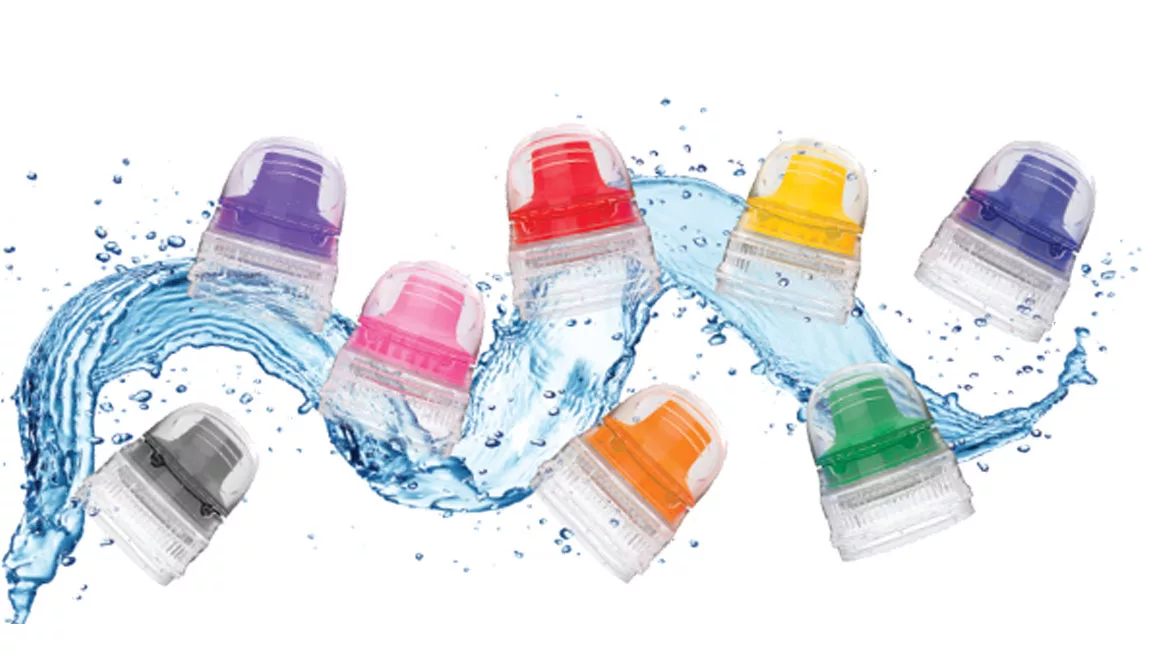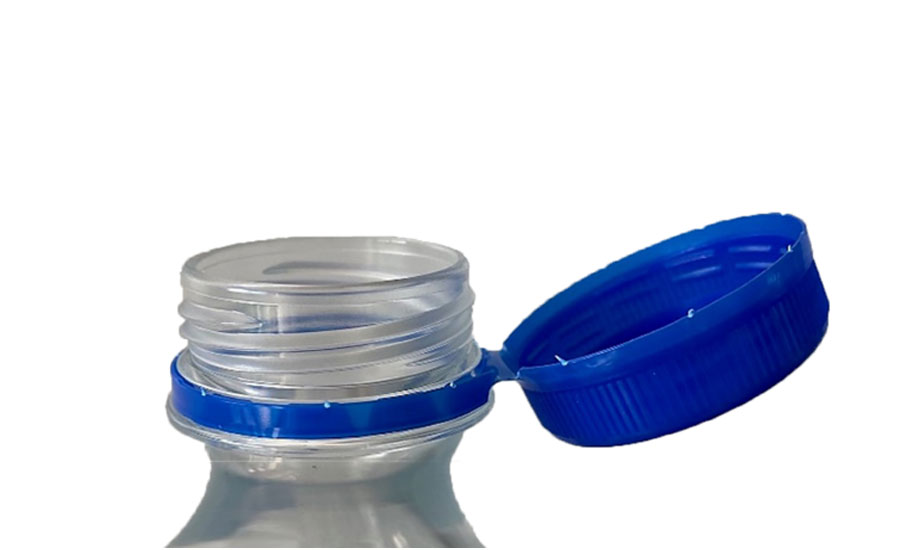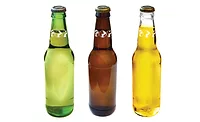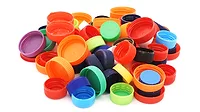Packaging Materials
Caps, closures provide protection, premiumization
Intelligent packaging to reach $46B by 2031

In November 2021, Novembal launched the Novactive 28, a new sports cap equipped with patented non-spill technology from SmartSeal for on-the-go beverages. The 1-liter bottle is available in various colors for 1881 and 1810 neck finishes.
Image courtesy of Novembal
In the Sunday school song “Open shut them,” children learn how to fold their hands to pray with “Open shut them give a little clap, Open shut them, Open shut them, lay them in your lap.” Within the beverage industry, consumers are able to “open and shut” a variety of caps and closures that not only protect the safety and efficacy of its contents, but are easy to open, tamper-resistant and biodegradable while also communicating the brand’s identity through a variety of colors, shapes and graphics.
Ismail Sutaria, senior consultant of packaging at Dubai, India-based Future Market Insights, highlights that consumers not only are looking for hygienic and spill-proof packaging formats, but also want smart, interactive, connected and user-friendly packaging.
“Today beverage manufacturers are using data integrated caps and closures that supports anti-counterfeiting and provide user must-know information through near-field communication (NFC) and blockchain technologies,” Sutaria explains. “Given the above, a California-based brand Böen, a part of Copper Cane Wines & Provisions in partnership with SharpEnd and Guala Closures, has introduced NFC technology-enabled wine bottle caps to connect with their consumers. Besides this, consumers are highly preferring [post-consumer resin] (PCR) plastic caps and closures that reduce carbon footprints and help to maintain a healthy environment.”

Image courtesy of Karma Culture LLC
The market is ripe for “intelligent packaging,” which is expected to reach $46.7 billion, expanding at a 9% compound annual growth rate (CAGR) from 2021-2031, Sutaria says. Millennials and Gen-Z are emerging as front-runners in adopting intelligent packaging formats, he adds.
However, smart technology is not the only factor influencing caps and closures.
Noting the “steady march toward more sustainable packaging,” Michael White, director of business development closures for Husky Injection Molding Systems, highlights the demand for increased sustainability within caps and closures, including lightweighting and tethering of closures while supporting the premiumization and differentiation that caps and closures can provide.
“There’s an increased grip zone to improve ease of use and increased closure height to enhance the perception of the package as a premium product offering,” White explains. “As consumers are hyper-focused about hygiene and safety, caps and closures provide protection. [Consumers are] looking for packaging to provide a reduced risk of virus contamination. The resealability of the PET plastic bottle plus a closure option is a solid hygienic alternative that provides a reduced risk of viral contamination as the threads are not exposed to the environment when the package is not in use ― provided the closure is reapplied properly. This increases demand for such dispensing systems.”
The Bolton, Ontario, Canada-based company offers an extensive portfolio of caps and closures in such beverage categories as water, carbonated soft drinks (CSDs) and juice drinks. It also highlights its commoditization, lightweighting, premiumization and speed to market attributes.

Image courtesy of Keurig Dr Pepper
“We offer a portfolio of closures matched to industry standard neck finishes. For brands looking to further differentiate their products, we also offer custom closure solutions for custom neck finishes,” White says. “The neck finish will determine the sealing system geometry (interior) required while the brand will have flexibility on the exterior aesthetics like knurl pattern, shell profile and overall height.”
As consumers are increasingly focused on their health and well-being, another trend impacting the packaging materials market is providing a canvas for branding while fostering increased awareness of the healthfulness of certain beverages. For instance, sugar content where a change in cap color can identify different flavor and ingredients combinations, for example, color “X” designates the original flavor while color “Y” indicates sugar free, White says.
Hats off to caps and corks
As the beverage market continues to evolve, new PET bottles, lighter wine bottles along with new dispensing caps, new sports caps and even wines sealed with natural cork closures are hitting the market. In fact, in the past few years, wines sealed with natural cork closures have risen twice as fast as those with screwcaps, new research commissioned by The Portuguese Cork Association (APCOR) found.
The nonprofit association analyzed the Top 1,500 wine SKUs in the United Kingdom and found that natural cork sealed wines are rising in price compared with those closed with a screwcap, increasing an average of $4.03 compared with its screwcap counterparts. Wines sealed with natural cork grew in price from an average of $9.34 in 2017 to $12.09 in 2021. In contrast, the average price for wines with screwcaps is $8.07, up from $7.32 in 2017.
Research suggests a value increase of 29% for natural cork sealed wines versus a value increase of 10% for wines closed with screwcaps. Being 100% renewable, natural and a recyclable product, wine corks also have seen a second life in space craft, high fashion and even as a collar for Barack Obama’s dog, it adds.

Image courtesy of TriMas Packaging
In a statement, APCOR Vice President João Rui Ferreira said: “It’s really interesting to see consumers trading up, not just in terms of wine value sales but it seems that there is an inherent interest in opting for cork sealed wines particularly amongst millennials.”
To assist on-the-go consumers working out or those who just want a “cool” bottle, in November 2021, Novembal, a part of the Sidel Group, launched a new sports cap equipped with patented non-spill technology from SmartSeal.
The new 1-liter, ultra-lightweight Novactive 28, available in various colors for 1881 and 1810 neck finishes, is equipped with a patented non-spill valve from Norway-based SmartSeal. Among its “100% no spill, no mess” features are a dust cap that locks at 180 degrees; a secure seal that allows pressurized contents up to 3 bar; and an upgraded tamper-evident band design that stays attached to the cap to avoid littering. The closures are made to support the closure lifecycle ― from the molding process to recycling, the company adds.
Available in North America and Latin America, Michelle Wycoff, director of new business development at Novembal, remarked: “The new Novactive 28 is a true game-changer for all beverage companies that want to offer a unique and differentiated solution to their consumers. … Consumers can turn the bottle upside-down, and no single drop will come out of the bottle. Combined with Novembal's extensive knowledge of the beverage market and customer service approach, our Novactive 28 is, without a doubt, the best recipe for all beverage producers. Our objective is to have the best available technology at their fingertips.”
Dispensing caps for premixed beverages
With functional beverages at the forefront, beverage-makers are searching for new, innovative ways to give consumers the vitamins, minerals and nutrients they want in revolutionary ways.
For beverage entrepreneur CJ Rapp, CEO of Karma Culture LLC, the concept of karma is simple: what goes around comes around.
Under his tutelage, the Pittsford, N.Y.-based company continues to forge new trails in wellness through the use of the Karma Push Cap — a user-friendly dispensing cap that contains a hermetic seal to protect the nutrients inside.
“The caps and closures market is expected to witness lucrative growth in the next three years. The beverage industry is predicted to hold a major chunk in this market.”
-- Ismail Sutaria, senior consultant of packaging at Future Market Insights
“The fact that active ingredients deteriorate in premixed RTDs is now an established fact,” Rapp says. “There is a very real need to stabilize the active ingredients. That way you deliver real nutrition. Premixed drinks require use of preservatives, whereas a dispensing cap is a non-GMO solution.”
Introduced in 2011 as the breakthrough component of Karma Wellness Water, the Karma Push Cap has evolved, with the injection molding, filling and assembly completed in 52 seconds in a pharmaceutical grade classroom. Fashioned out of recyclable materials, the PET cap is made from low-density polyethylene (LDPE), he adds.
Given the rise in CBD drinks, Rapp notes that a Karma CBD will hit the market soon. “We can protect the CBD from deterioration, thus assuring optimal potency and the full entourage effect,” he says.
Customization, convenience for closures
Experts note that SKU proliferation and changeover are part of the caps and closures business and are being developed to fulfill consumers’ requirements for cost, customization, ease- of use, branding capability, sustainability and more.
Husky Injection Molding Systems’ White notes that the explosion of SKUs and different format sizes of the same beverage are becoming the norm. “By introducing different format sizes for the same beverage, there are opportunities for smaller neck finish options to match package proportions and eliminate waste (e.g., 1881 versus 26/22 CSD),” he says.
He explains that customers are expecting high performance from closures that feature carbon dioxide retention, opening torque, removal torque, high temperature cycling, and that also pass secure seal and drop tests.
“Ease-of-use is important, especially in the case of tethered closures,” White explains. “Brands are demanding that the tethering mechanism is intuitive and simple to operate. [They also want manufacturers to] deliver consistently high-quality closures in terms of dimensional criteria and aesthetic criteria.”
Lightweight solutions, compatibility with industry standard neck finishes and customization also are crucial, according to White.
“We ask ‘how can we eliminate excess material in the closure without compromising performance and functionality?,’” he says. “As new neck finishes are standardized on the market, there is a need for new closure designs. Offering a compatible and high-performance closure design at neck finish launch can provide brand owners with a competitive advantage in terms of speed to market.”
White adds that customers occasionally inquire about modifying features either to give the closure better performance, user experience or differentiation.
Future Market Insights’ Sutaria expresses similar sentiments. “High demand for personalization, convenience, and affordability is expected to drive SKU proliferation to the next frontier,” he says. “As caps and closures manufacturers now are required to meet the demand generated from rising eCommerce and sustainability requirements along with satisfying consumer preferences, this, in turn, will shift focus to SKUs that provide closures to various packaging formats.”
With convenience and personalization driving importance in the caps and closures market, Sutaria expects that packaging manufacturers will continue to look for creative ways to drive growth and innovation in the face of an increasing number of SKUs.
“This is likely to remain a prominent trend that will ‘change the game’ in the caps and closures manufacturing industry over the next five to 10 years,” Sutaria says. “The caps and closures market is expected to witness lucrative growth in the next three years. The beverage industry is predicted to hold a major chunk in this market. Per capita consumption of packed water followed by packed alcoholic beverages, milk and dairy products, and CSD beverages is remarkably increasing across various nations. As these products are mostly available in bottles, stand-up pouch, bag-in-box, and many other packaging formats, the demand for caps and closures is expected to bolster in coming years.”
Looking for a reprint of this article?
From high-res PDFs to custom plaques, order your copy today!





